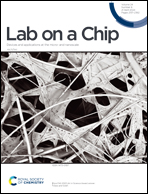An economical in-class sticker microfluidic activity develops student expertise in microscale physics and device manufacturing†
Abstract
Educating new students in miniaturization science remains challenging due to the non-intuitive behavior of microscale objects and specialized layer-by-layer assembly approaches. In our analysis of the existing literature, we noted that it remains difficult to have low cost activities that elicit deep learning. Furthermore, few activities have stated learning goals and measurements of effectiveness. To that end, we created a new educational activity that enables students to build and test microfluidic mixers, valves, and bubble generators in the classroom setting with inexpensive, widely-available materials. Although undergraduate and graduate engineering students are able to successfully construct the devices, our activity is unique in that the focus is not on successfully building and operating each device. Instead, it is to gain understanding about miniaturization science, device design, and construction so as to be able to do so independently. Our data show that the activity is appropriate for developing the conceptual understanding of graduate and advanced undergraduate students (n = 57), as well as makes a lasting impression on the students. We also report on observations related to student patterns of misunderstanding and how miniaturization science provides a unique opportunity for educational researchers to elicit and study misconceptions. More broadly, since this activity teaches participants a viable approach to creating microsystems and can be implemented in nearly any global setting, our work democratizes the education of miniaturization science. Noting the broad potential of point-of-care technologies in the global setting, such an activity could empower local experts to address their needs.



 Please wait while we load your content...
Please wait while we load your content...